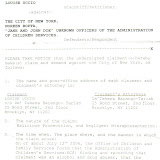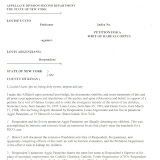Interestingly I came across this article today, it's been known or at least suspected since 1998 that personality disorders destroy lives of those living with or around one with a personality disorder. Yet there is still so much controversy, why? This is simple basic psych yet thousands of children's lives are destroyed daily while these sick &%$# are allowed to dominate. Leaves you wondering why, perhaps those with the power to stop it chose not to. Can it be they are themselves suffering from personality disorders and want the future of America to be heartless souls? Things that make ya go hmmmmmmmm ..
The article below was written in 1998, much has changed since then, but PAS should be a thing of the past, we now have the tools to figure out who the alienators are and how they operate. So why are millions of children being emotionally abused by these psychopaths daily?
AMERICAN JOURNAL OF FORENSIC PSYCHOLOGY,
Volume 16, Number 4, 1998, p. 5-14
MMPI-2 VALIDITY SCALES AND SUSPECTED PARENTAL ALIENATION SYNDROME
by Jeffrey C. Siegel, Ph.D. and Joseph S. Langford, Ph.D
MMPI-2 VALIDITY SCALES AND SUSPECTED PARENTAL ALIENATION SYNDROME
by Jeffrey C. Siegel, Ph.D. and Joseph S. Langford, Ph.D
MMPI-2 validity scales of two groups of parents going through child custody evaluations, parents who engage in parental alienation syndrome (PAS) behaviors and parents who do not, were compared. It was hypothesized that PAS parents would have significantly higher L and K scales and a significantly lower F scale than parents who do not engage in these behaviors. Using female subjects, since few males were available, the hypothesis was confirmed for K and F scales, indicating that PAS parents are more likely to complete MMPI-2 questions in a defensive manner, striving to appear as flawless as possible. It was concluded that parents who engage in alienating behaviors are more likely than other parents to use the psychological defenses of denial and projection, which are associated with this validity scale pattern. Implications of this finding regarding possible personality disorders in PAS parents are discussed.
Parental alienation syndrome is a term coined by Gardner (1, 2) for the phenomenon in which a child from a broken marriage becomes alienated from one parent due to the active efforts of the other parent to sever their relationship. Rand (3) recently provided an extensive review of the literature relevant to this phenomenon, broadening the scope to include writing which described the same or similar Concepts without using Gardner's term. Gardner and others (4, 5) have described numerous behaviors the alienating parent may engage in to harm the child's relationship with the other parent, many of which have been described as "programming" or "brainwashing." For example, the alienating parent is likely to make accusations about the other parent in front of the child, describe the other parent as dangerous or harmful, tell the child that the other parent does not love him or her, and greatly exaggerate the other parent's faults (whether real or imagined). More extreme alienating behaviors include making false accusations of sexual or physical abuse and programming the child to believe that the abuse occurred. According to Gardner, the child becomes aware that the alienating parent wants him or her to hate the other parent and, out of the need to please the alienating parent and to avoid abandonment or rejection, the child joins in the denigration of the other parent.
Such dynamics are very familiar to clinicians who work with broken families and who perform custody evaluations. As Rand's review (3) makes clear, an increasing number of theoretical writings, case studies, and anecdotal accounts related to this phenomenon have begun to appear in the literature, some of which use the term PAS (6-8) and others which use different terminology (4, 5, 9, 10). However, little empirical research has yet been reported. A number of questions need to be addressed through research. For example, how prevalent is this phenomenon? Is it correlated with certain personality traits or psychological disorders? What are the short-term and long-term effects on children who are subjected to it? How does a clinician recognize it? Can psychological testing help the clinician discern when it may be present? Opinions have been expressed about many of these questions by Gardner and others, but they have not yet been subjected to hypothesis testing. Since the U.S. Supreme Court's ruling in Daubert v. Merrill Dow Pharmaceuticals, Inc. (11), testimony about PAS is not likely to be found widely admissible in court without a solid research base.
The present study is an attempt to gain understanding of parents who engage in alienating tactics through a statistical examination of their MMPI-2 validity scales. It was reasoned that if any patterns emerge in the test results of alienating parents, a better understanding of their behaviors might be gained, as well as a psychometric tool to help in the identification of the phenomenon.
In this study, the MMPI-2 profiles of divorcing parents exhibiting characteristics of parental alienation syndrome were compared with the standard MMPI-2 normative sample and with the profile of divorcing parents who do not exhibit characteristics of the syndrome. The specific hypothesis tested was that parents who engage in parental alienation would have significantly higher elevations on the L and K scales and lower elevations on the F scale than both the standard MMPI-2 normative sample and a sample of divorcing parents who do not engage in parental alienation. It was reasoned that persons who try to alienate their children from the other parent are likely to have a higher degree of the behaviors associated with high L and K scores and a low F score, including a wish to be seen as near flawless, a heavy use of denial defenses (12), a tendency to be rigid and moralistic, and a low degree of awareness of the consequences of their own behavior to other people (13).
Siegel (14) has previously found that males and females undergoing child custody evaluation tend to produce significantly elevated L and K scores and males produce F scores significantly below the MMPI-2 normative sample. If the hypothesis of this study is correct, parental alienators in custody disputes would be expected to follow that pattern to a greater degree than parents in custody disputes who do not use alienating tactics.
METHOD
Subjects
The subjects for the study were 34 females who completed the MMPI-2 in the course of child custody evaluations. Thirty of the subjects were evaluated in the authors' practice, while four were contributed by another psychologist who frequently serves as an expert witness for the family courts of Dallas, Texas. All of the subjects were involved in child custody litigation and were referred by their attorneys or by the court for psychological evaluation to assist the court in determining the best interest of the children.
Classification Into Groups
The MMPI-2 results of all the clients involved in child custody evaluations in the authors' practice over the last three years were first removed from the files so that classifications would be made as "blind" as possible The records of the evaluations were then reviewed and subjects classified into a parental alienation syndrome (PAS) group and a non-parental alienation (non-PAS) group, according to criteria developed from Gardner's (2) and Turkat's (4) descriptions of alienating tactics commonly used by parents.
The psychologist who contributed four additional PAS subjects' records picked them out of her case files using the same criteria. She did not know the study's hypothesis.
The PAS criteria were as follows:
Personally involved in, or involving others in, malicious acts against the other parent
Engages in excessive litigation for the purpose of limiting the other parent's access to their children
Attempts to obstruct regular visitation with the other parent
Obstructs the other parent's participation in the children's school life and extracurricular activities by lack of notification or untimely notification
Lying to the children
Lying to others (including, but not limited to, child welfare and child abuse workers, school personnel, medical and psychological professionals)
Violations of law (court orders, enforceable agreed orders regarding access, etc.)
False allegations of physical, emotional, and/or sexual abuse (falsehood determined by collateral information from child protective service agencies, physicians, psychologists, or other reputable sources)
Sixteen subjects met the criteria for classification as PAS parents (age range: 30 years old to 45 years old, mean = 38.1 years), while 18 subjects did not and were placed in the non-PAS subject pool (age range: 27 years old to 44 years old, mean = 36.9 years).
Procedure
The MMPI-2 was administered as part of the standard battery given to each parent in a custody evaluation. Standard MMPI-2 conditions and instructions were employed. Only female subjects were used in the data analysis due to a limited number of male subjects available for the statistical comparison. This limitation is consistent with the previously referenced work of Gardner (2) and Turkat (4), who report that the majority of persons exhibiting alienation behaviors are female.
Analysis
Two tailed t-tests were used to compare parental alienators' mean scores on the MMPI-2 validity scales to the MMPI-2 normative sample and the sample of divorcing parents who do not exhibit alienating behaviors.
RESULTS
The study's hypothesis was confirmed for two of the three validity scales. Results of the t-tests indicate that mothers exhibiting PAS behaviors had significantly higher scores on the K scale and significantly lower scores on the F scale than both the standard MMPI-2 normative sample and the sample of divorcing mothers who do not engage in parental alienation. There was no significant difference in L scale scores between the alienating and nonalienating groups, although both were higher than the published normative sample. The results of these statistical analyses are presented in Tables 1 and 2. Figure 1 presents the results in T-scores as they would appear on a typical MMPI-2 profile.
Table 1. Comparison of Validity Scales of Suspected PAS Mothers In Custody Suits With Standard MMPI-2 Norms
Scale PAS Subjects Standard MMPI-2 Norms*
M SD M SD t
L 5.69 2.8 3.47 1.98 3.17***
F 2.25 1.92 3.39 2.64 -2.375**
K 22.44 3.48 15.34 4.47 8.161***
* Caucasian normative group from Butcher J et al. (15)
** p<.01***
p <.005
Table 2. Comparison of Validity Scales of Suspected PAS and Non-PAS Mothers in Custody Suits
Scale PAS Subjects Non-PAS Subjects
M SD M SD t
L 5.69 2.8 5.46 2.41 .329(ns)
F 2.25 1.92 3.23 3.39 -2.042*
K 22.44 3.48 18.92 4.25 4.046**
* p<.01**
p<.005
Figure 1. Comparison of Validity Scale Profiles of Suspected PAS Mothers, Non-PAS Mothers and MMPI-2 Normative Group
Figures, Discussion and more..























No comments:
Post a Comment